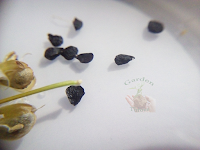 |
| Native na kutchay na nakatanim sa flowerbox namin |
Ang kutchay o garlic chives Allium tuberosum ay flat ang dahon kumpara sa dahon ng sibuyas. Kung hindi ka marunong tumingin, puwede mo siyang pagkamalang ligaw na damo. Mas malakas ang amoy nito at mas malasa. Sa mga nakapunta na ng Korea, gustong gusto nila ito sa omellete. Masarap din siyang pampalasa at pampabango sa gyoza.
Paano magtanim
Dalawa ang paraan kung paano simulan ang kutchay. 1) mula sa buto; 2) mula sa pinag-tanggalan o division mula sa malagong halaman. Ang lupa na pagtataniman ay dapat buhaghag. Hindi ito dapat maputik na nag-iipon ng tubig, o masyadong buhaghag na madali itong matuyuan.
Mula sa pinag-tanggalan
Mas mabilis kapag magsisimula ka sa pinagkuhaan na kutchay kasi hindi mo na siya hihintaying umusbong. Kapag hihingi ka sa kakilala mo, kinakailangang mahahaba at marami ang mga ugat. Maghukay ng malalim at malawak, mga tatlong beses ang lapad ng iyong kutchay. Sa gitna ng hukay ay dapat may maliit na bundok. Spread mo lang yung mga ugat sa ibabaw non at takpan ng lupa. Dapat mabaon ang kutchay ng 2 inches sa lupa. Diligan ito maigi at hayaang lumago. Kung nasa paso, itabi lang sa lilim ng mga 3 araw para hindi ito malanta.
 |
| Buto ng kutchay |
Mula sa buto
Nakakuha ako ng mga buto mula sa mga alaga ko. Kadalasan ang isang dahilan ng paglago ng kutchay ay dahil sa mga naglalaglagang mga buto nito.
Basain ang lupa ng pagtataniman mo. Maghukay ng maliit na butas na mga 1/4 inch na lalim lupa at ipunla ang mga buto. Puwede kang maglagay ng 2-3 na mga buto kada butas. Diligan ang ang mga ito at huwag hayaang matuyo ang lupa.
Depende sa ganda ng mga buto at init ng lupa, makakakita ka ng usbong mga 5 araw pagka-punla. Kadalasan ay maghihintay ka ng mga 1-2 linggo bago ka makakita ng usbong.
Hindi masyadong gusto ng kutchay ang basang o tuyong lupa. Kinakailangan ay mamasa-masa ang lupa. Diligan ang kutchay kada 1-2 araw, depende kung gaano katuyo ang lupa. Kung naninilaw ang mga dahon, itsok ang barbecue stick sa lupa ng mga 2 inches. Kung lumabas ito na basa, nasosobrahan ito sa dilig. Kung lumabas ito ng tuyo, kinakailangan nang diligan ang kutchay.
Hindi masyadong gusto ng kutchay ang basang o tuyong lupa. Kinakailangan ay mamasa-masa ang lupa. Diligan ang kutchay kada 1-2 araw, depende kung gaano katuyo ang lupa. Kung naninilaw ang mga dahon, itsok ang barbecue stick sa lupa ng mga 2 inches. Kung lumabas ito na basa, nasosobrahan ito sa dilig. Kung lumabas ito ng tuyo, kinakailangan nang diligan ang kutchay.
Pataba
 |
| Bulaklak ng kutchay at mga buto |
Ani
Puwede kang kumuha ng kutchay pagkaraan ng 1-2 mos simula sa pag-usbong. Mas lumalago ang kutchay kapag madalas mong kinukuhaan ng dahon. Magkaiba ang bilis ng lago ng kutchay kapag native ito o galing ibang bansa. Mas maliit at maninipis ang dahon ng native kumpara sa mga galing China o Amerika na buto.
 |
| Pollen mula sa kutchay |
Kung walang mga paro-paro o bubuyog sa lugar niyo, maaring mahirapan kang magkaroon ng mga buto mula sa iyong kutchay. Siguro mga halos kalahating taon hind ako makakuha-kuha ng buto mula sa mga alaga ko. May ginawa akong experiment. Manual pollination. Kumuha ako ng pollen mula sa mga bulaklak at kinalat ko siya sa mga bulaklak. Ingat lang. Kung allergic ka sa pollen, wag mong gawin ito.
Masarap ang kutchay kapag sarili mong ani. Maaaring maghihintay ka ng matagal, pero kapag lumago na ito, soobra pa ito sa kinakailangan mo. Kung may tanong po kayo kung paano alagaan ang kutchay, huwag po kayong mahiya na magsabi sa comment section sa baba!











